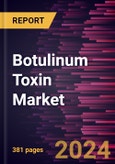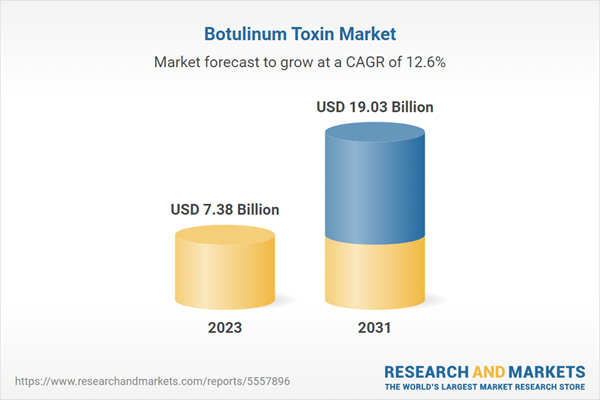According to our latest study on Botulinum Toxin Market Forecast to 2031 - Global Analysis - by Product, Application, and End User the market was valued at US$ 7.38 billion in 2023 and is expected to reach US$ 19.03 billion by 2030. It is estimated to register a CAGR of 12.6% from 2023 to 2031.
Botulinum toxins are neurotoxins produced by bacteria named Clostridium botulinum. After the toxin is injected into a muscle, it blocks nerve signals to the muscle, thereby blocking its contraction and reducing unwanted facial lines or features. Botulinum toxin injections such as Botox and Dysport improve the appearance by relaxing the muscles that cause wrinkles. These injections also treat migraines, hyperhidrosis, overactive bladder, and eye problems.
Noninvasive procedures of facial rejuvenation using injections of botulinum toxin, calcium hydroxylapatite, and hyaluronic acid, among others. These procedures have minimal side effects and help reduce cellulite, wrinkles, facial lines, and unwanted fat. The concept of natural rejuvenation is based on a comprehensive, multilayered, three-dimensional approach that combines multiple techniques and active ingredients in procedures such as volume enlargement, skin relaxation, reshaping, volume repositioning, skin tightening, and surface renewal, depending on specific needs of patients. The most often used non-surgical face procedures are chemical peels, laser skin resurfacing, soft tissue fillers, and Botox. Unlike surgical procedures that are associated with greater risks, minimally invasive procedures benefit patients through faster recovery, lesser scarring, limited stress, and better patient satisfaction. Moreover, changing consumer views about wellness, beauty, and good aging results in a better understanding and acceptance of aesthetics worldwide. According to the International Society of Aesthetic Plastic Surgery (ISAPS), the number of nonsurgical procedures increased by 19.9% in 2021 compared to 2020. The total number of nonsurgical procedures was 17.5 million in 2021. Thus, an upsurge in the adoption of noninvasive aesthetic procedures is driving the growth of the botulinum toxin market.
International Society of Aesthetic Plastic Surgery, and National Institute for Health and Care Excellence are a few of the major secondary sources referred to while preparing the report on the botulinum toxin market.
Botulinum toxins are neurotoxins produced by bacteria named Clostridium botulinum. After the toxin is injected into a muscle, it blocks nerve signals to the muscle, thereby blocking its contraction and reducing unwanted facial lines or features. Botulinum toxin injections such as Botox and Dysport improve the appearance by relaxing the muscles that cause wrinkles. These injections also treat migraines, hyperhidrosis, overactive bladder, and eye problems.
Noninvasive procedures of facial rejuvenation using injections of botulinum toxin, calcium hydroxylapatite, and hyaluronic acid, among others. These procedures have minimal side effects and help reduce cellulite, wrinkles, facial lines, and unwanted fat. The concept of natural rejuvenation is based on a comprehensive, multilayered, three-dimensional approach that combines multiple techniques and active ingredients in procedures such as volume enlargement, skin relaxation, reshaping, volume repositioning, skin tightening, and surface renewal, depending on specific needs of patients. The most often used non-surgical face procedures are chemical peels, laser skin resurfacing, soft tissue fillers, and Botox. Unlike surgical procedures that are associated with greater risks, minimally invasive procedures benefit patients through faster recovery, lesser scarring, limited stress, and better patient satisfaction. Moreover, changing consumer views about wellness, beauty, and good aging results in a better understanding and acceptance of aesthetics worldwide. According to the International Society of Aesthetic Plastic Surgery (ISAPS), the number of nonsurgical procedures increased by 19.9% in 2021 compared to 2020. The total number of nonsurgical procedures was 17.5 million in 2021. Thus, an upsurge in the adoption of noninvasive aesthetic procedures is driving the growth of the botulinum toxin market.
By Application, Botulinum Toxin Market-Based Insights
The botulinum toxin market, by application, is bifurcated into medical and aesthetic. The medical segment held the largest botulinum toxin market share in 2023 and is anticipated to register the highest CAGR of 13.3% during 2023-2031. The medical segment is further categorized into chronic migraine, muscle spasm, over reactive bladder, hyperhidrosis, and others. The market for the aesthetic segment is further divided into frown lines/ glabellar, forehead lines, crow’s feet, square jaw/ masseter, and others. Botulinum toxin is a neurotoxin used to treat and manage various medical conditions, including chronic migraine, spastic disorders, cervical dystonia, and detrusor hyperactivity. Medical applications of botulinum toxin include chronic migraine, muscle spasms, overreactive bladder, and hyperhidrosis. Chronic migraine is a severely disabling neurological disorder characterized by pulsating unilateral or bilateral headaches. It is primarily described as a headache that troubles individuals for at least 15 days per month for three months. Botulinum toxin injections have also been found to be effective in treating cerebral palsy, providing patients with major relief from severe muscle contraction. Botulinum toxin A has also been studied for its effectiveness in treating chronic lower back pain.By End User, Botulinum Toxin Market-Based Insights
In terms of type, the botulinum toxin market is categorized into specialty and dermatology clinics, hospitals and clinics, and others. The specialty and dermatology clinics segment held the largest market share in 2023. The botulinum toxin market growth in this segment is attributed to the patients’ inclination toward dermatology clinics for their specialized dermatology treatment needs, and the ability of these clinics to provide rapid and effective services. These patients usually have specific skin conditions that require expert evaluation and management. Botulinum toxin treatments offered in dermatology clinics are tailored to address these specific concerns, with customized formulations designed to target the underlying causes of skin problems. Cosmetic procedures have become more widespread in the last 10 years. Moreover, the introduction of minimally invasive techniques has added to the popularity of dermatological procedures. Botulinum toxin injections, hyaluronic acid treatments, laser hair removal, nonsurgical fat reduction, and photorejuvenation/intense pulse light (IPL) have been the most common nonsurgical cosmetic procedures that are performed in dermatology clinics.International Society of Aesthetic Plastic Surgery, and National Institute for Health and Care Excellence are a few of the major secondary sources referred to while preparing the report on the botulinum toxin market.
Table of Contents
1. Introduction
2. Executive Summary
4. Botulinum Toxin Market Landscape
5. Botulinum Toxin Market - Key Market Dynamics
6. Botulinum Toxin Market - Global Market Analysis
7. Botulinum Toxin Market - Revenue Analysis (USD Million) - By Product, 2021-2031
8. Botulinum Toxin Market - Revenue Analysis (USD Million) - By Application, 2021-2031
9. Botulinum Toxin Market - Revenue Analysis (USD Million) - By End User, 2021-2031
10. Botulinum Toxin Market - Revenue Analysis (USD Million), 2021-2031 - Geographical Analysis
11. Industry Landscape
12. Competitive Landscape
13. Botulinum Toxin Market - Key Company Profiles
14. Appendix
List of Tables
List of Tables
Companies Mentioned
- F. Hoffmann-La Roche Ltd
- Becton Dickinson and Co
- ARKRAY Inc
- Sysmex Partec GmbH
- Fujirebio Europe NV
- bioMerieux SA
- Cepheid
- Meril Life Sciences Pvt Ltd
- QIAGEN NV
- OraSure Technologies Inc
Table Information
| Report Attribute | Details |
|---|---|
| No. of Pages | 381 |
| Published | May 2024 |
| Forecast Period | 2023 - 2031 |
| Estimated Market Value ( USD | $ 7.38 Billion |
| Forecasted Market Value ( USD | $ 19.03 Billion |
| Compound Annual Growth Rate | 12.6% |
| Regions Covered | Global |
| No. of Companies Mentioned | 10 |









